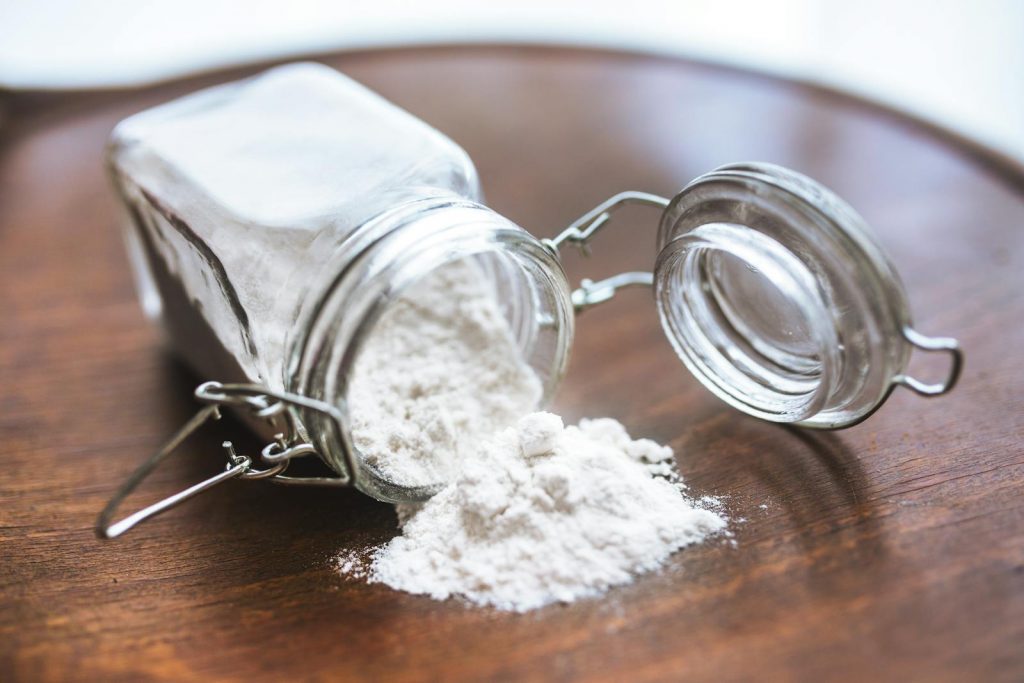What’s the Difference Between Baking Soda and Baking Powder?

Baking soda and baking powder are essential ingredients in baking, often used to help baked goods rise and achieve a light, fluffy texture. While they may look similar and are sometimes used interchangeably, baking soda and baking powder have distinct chemical compositions and functions. Each works differently to create the right level of leavening, which is the process of causing dough or batter to expand and lighten. Understanding these differences is essential for achieving the desired results in baking, as using one in place of the other can lead to unexpected outcomes in texture, flavor, and appearance.
This guide explores the chemistry behind baking soda and baking powder, how they differ, and when to use each to enhance the texture and flavor of your favorite recipes.
What is Baking Soda?
Baking soda, also known as sodium bicarbonate, is a highly alkaline compound with a strong, salty flavor that is commonly used as a leavening agent in baking. It is a single ingredient, meaning it requires an acid to activate its leavening properties. When baking soda is combined with an acid, such as lemon juice, vinegar, yogurt, or buttermilk, it produces carbon dioxide gas. This gas forms bubbles, which expand and create air pockets within the dough or batter, causing it to rise and develop a light, airy texture. However, without an acidic component, baking soda remains inactive and does not provide any leavening.
Baking soda is a potent leavening agent, and only a small amount is typically required to achieve the desired rise. However, because it has a strong alkaline flavor, using too much can impart a bitter or metallic taste to baked goods. This is why baking soda is often used in recipes with other strong flavors or acidic ingredients to balance its taste. It’s also worth noting that baking soda begins to work immediately upon contact with an acid, which means that batters containing baking soda should be baked right away to prevent the loss of air bubbles and ensure the best texture.
In addition to baking, baking soda has many household uses, such as cleaning and deodorizing. Its versatility as a chemical compound makes it a common pantry staple, but its specific role as a leavening agent in baking is what makes it so valuable in the kitchen.
What is Baking Powder?
Baking powder is a leavening agent that contains both baking soda and an acid in the form of a dry compound, usually cream of tartar. Baking powder also includes a stabilizer, such as cornstarch, which prevents the baking soda and acid from reacting until the powder is mixed with moisture. Because it contains both an acid and an alkaline compound, baking powder does not require any additional acidic ingredients to activate it; it is “double-acting” in most cases, which means it reacts twice during the baking process—first when it comes into contact with liquid, and again when exposed to heat in the oven.
This double-acting property makes baking powder convenient for recipes that do not contain naturally acidic ingredients, as it provides consistent leavening throughout the baking process. It also allows for greater control over the rising process, creating a lighter, fluffier texture in baked goods like cakes, muffins, and pancakes. Unlike baking soda, baking powder has a neutral taste, so it does not affect the overall flavor of the recipe as strongly as baking soda might.
The amount of baking powder required in recipes is generally higher than baking soda, as it contains additional ingredients that balance its leavening power. This versatility makes baking powder a reliable choice for recipes without acidic elements, ensuring a uniform rise without the need for added acidic ingredients.
Key Differences Between Baking Soda and Baking Powder
The main differences between baking soda and baking powder lie in their chemical composition, reactivity, and usage in recipes. Baking soda is a single compound that requires an acid to activate, while baking powder is a pre-mixed combination of an acid and a base, making it self-activating when combined with liquid. This distinction is important because baking soda relies on acidic ingredients like vinegar or buttermilk to produce the gas needed for leavening, while baking powder can work independently to create the necessary rise.
Baking soda is more potent than baking powder as a leavening agent; it provides a strong initial reaction but must be baked quickly to maintain the gas bubbles produced by the chemical reaction. In contrast, baking powder’s double-acting nature allows for a slower release of gas, providing a more consistent rise during baking. This controlled reaction is especially useful in recipes where the batter may need to sit for a bit before baking, as it helps retain the leavening effect and ensures even rising.
Another key difference is flavor. Baking soda, being alkaline, has a slightly salty, metallic taste, which is why recipes using baking soda often contain ingredients with strong flavors that can mask or balance this taste. Baking powder, on the other hand, is more neutral, allowing it to be used in a wider variety of recipes without impacting flavor. Knowing these differences helps bakers choose the right leavening agent for each recipe, ensuring the correct texture and taste.
When to Use Baking Soda
Baking soda is typically used in recipes that already contain acidic ingredients, such as lemon juice, yogurt, vinegar, or buttermilk. The acid in these ingredients reacts with the baking soda to produce carbon dioxide gas, creating air bubbles that lead to a rise in the batter or dough. Baking soda’s strong leavening power makes it ideal for recipes that require a quick rise, such as cookies, muffins, and certain cakes. It also works well in recipes that benefit from a slightly crisper texture, as it contributes to browning during baking.
One common example of baking soda in action is chocolate cake, where cocoa powder (a mildly acidic ingredient) activates the baking soda, resulting in a moist, airy texture. Similarly, baking soda is often used in recipes for buttermilk pancakes, where the acidity of buttermilk helps produce fluffy, tender pancakes. Because baking soda’s reaction occurs immediately, recipes using baking soda should be baked soon after mixing to prevent the loss of gas bubbles.
In addition to leavening, baking soda can contribute to browning, which enhances flavor and creates a visually appealing appearance in baked goods. When baking soda is used correctly, it not only aids in rising but also contributes to a more complex taste profile, making it a valuable ingredient for recipes with acidic elements.
When to Use Baking Powder
Baking powder is ideal for recipes that do not contain any naturally acidic ingredients, as it does not rely on an external acid to activate. Because baking powder is double-acting, it provides a consistent rise throughout the baking process. This makes it a perfect choice for cakes, quick breads, and pastries that need a light, fluffy texture but lack acidic components. The double-acting nature of baking powder also allows for some flexibility, as the first reaction occurs upon mixing with liquid, and the second reaction takes place when exposed to oven heat, ensuring the rise is maintained during baking.
An example of baking powder’s utility is in classic vanilla cake, where the recipe lacks acidic ingredients, and baking powder serves as the primary leavening agent. Similarly, in recipes for biscuits or scones, baking powder provides the lift needed to create a tender, flaky texture without altering the flavor. It’s also commonly used in pancakes and waffles when a neutral leavening agent is preferred, resulting in a consistent rise and an even texture.
For recipes that require a slow, even rise, baking powder’s predictable leavening power offers a reliable option, making it suitable for delicate baked goods. Its neutral flavor allows the other ingredients to shine without interference, which is particularly important in subtle-flavored recipes.
Can You Substitute Baking Soda for Baking Powder (and Vice Versa)?
While substituting baking soda for baking powder or vice versa can sometimes work in a pinch, it often requires adjustments to maintain the desired texture and flavor of the recipe. Baking soda is much stronger than baking powder, so if substituting baking powder with baking soda, only one-third of the amount should be used, and an acidic ingredient must be added to activate it. For example, if a recipe calls for one teaspoon of baking powder, you can use one-third of a teaspoon of baking soda and add an acidic element like lemon juice or vinegar.
Conversely, substituting baking powder for baking soda requires about three times as much baking powder to achieve a similar leavening effect. However, this may not always be practical, as adding too much baking powder can create an overly bitter taste. The additional ingredients in baking powder, like cream of tartar and cornstarch, may also affect the flavor and texture of the final product.
In most cases, it’s best to use the specific leavening agent called for in the recipe to avoid unintended changes in taste and texture. If a substitute must be made, understanding how to balance acidity and leavening strength can help make the adjustment work. Keeping both baking soda and baking powder on hand ensures that you have the right ingredient available for any recipe.
Final Words
Understanding the difference between baking soda and baking powder is essential for successful baking, as each serves a distinct purpose. Baking soda, a pure alkaline compound, requires an acid to activate its leavening properties and is commonly used in recipes with acidic ingredients. Baking powder, on the other hand, is a balanced combination of an acid and a base, allowing it to act independently as a leavening agent in recipes without acidic components. This dual nature makes baking powder a versatile choice, while baking soda’s quick, strong rise is ideal for recipes that need immediate leavening.
Each leavening agent offers unique benefits that contribute to the flavor, texture, and appearance of baked goods. Knowing when and how to use each—whether to achieve a tender, fluffy cake or a crisp, golden cookie—empowers bakers to experiment and refine their techniques. While substitutions between baking soda and baking powder can be made, they require careful adjustments to ensure the recipe’s success. By understanding these differences, bakers can make informed choices that enhance their creations and bring out the best in their favorite recipes.



